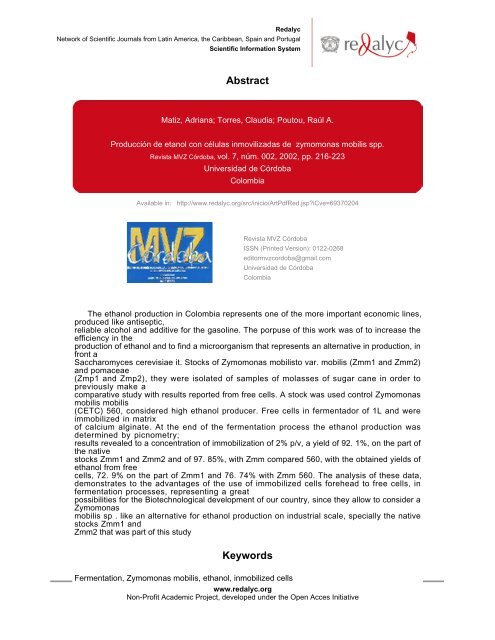Redalyc. Abstract. Producción de etanol con células inmovilizadas ...
Redalyc. Abstract. Producción de etanol con células inmovilizadas ...
Redalyc. Abstract. Producción de etanol con células inmovilizadas ...
Create successful ePaper yourself
Turn your PDF publications into a flip-book with our unique Google optimized e-Paper software.
<strong>Abstract</strong><br />
<strong>Redalyc</strong><br />
Network of Scientific Journals from Latin America, the Caribbean, Spain and Portugal<br />
Scientific Information System<br />
Matiz, Adriana; Torres, Claudia; Poutou, Raúl A.<br />
<strong>Producción</strong> <strong>de</strong> <strong>etanol</strong> <strong>con</strong> <strong>células</strong> <strong>inmovilizadas</strong> <strong>de</strong> zymomonas mobilis spp.<br />
Revista MVZ Córdoba, vol. 7, núm. 002, 2002, pp. 216-223<br />
Universidad <strong>de</strong> Córdoba<br />
Colombia<br />
Available in: http://www.redalyc.org/src/inicio/ArtPdfRed.jsp?iCve=69370204<br />
Revista MVZ Córdoba<br />
ISSN (Printed Version): 0122-0268<br />
editormvzcordoba@gmail.com<br />
Universidad <strong>de</strong> Córdoba<br />
Colombia<br />
The ethanol production in Colombia represents one of the more important e<strong>con</strong>omic lines,<br />
produced like antiseptic,<br />
reliable alcohol and additive for the gasoline. The porpuse of this work was of to increase the<br />
efficiency in the<br />
production of ethanol and to find a microorganism that represents an alternative in production, in<br />
front a<br />
Saccharomyces cerevisiae it. Stocks of Zymomonas mobilisto var. mobilis (Zmm1 and Zmm2)<br />
and pomaceae<br />
(Zmp1 and Zmp2), they were isolated of samples of molasses of sugar cane in or<strong>de</strong>r to<br />
previously make a<br />
comparative study with results reported from free cells. A stock was used <strong>con</strong>trol Zymomonas<br />
mobilis mobilis<br />
(CETC) 560, <strong>con</strong>si<strong>de</strong>red high ethanol producer. Free cells in fermentador of 1L and were<br />
immobilized in matrix<br />
of calcium alginate. At the end of the fermentation process the ethanol production was<br />
<strong>de</strong>termined by picnometry;<br />
results revealed to a <strong>con</strong>centration of immobilization of 2% p/v, a yield of 92. 1%, on the part of<br />
the native<br />
stocks Zmm1 and Zmm2 and of 97. 85%, with Zmm compared 560, with the obtained yields of<br />
ethanol from free<br />
cells, 72. 9% on the part of Zmm1 and 76. 74% with Zmm 560. The analysis of these data,<br />
<strong>de</strong>monstrates to the advantages of the use of immobilized cells forehead to free cells, in<br />
fermentation processes, representing a great<br />
possibilities for the Biotechnological <strong>de</strong>velopment of our country, since they allow to <strong>con</strong>si<strong>de</strong>r a<br />
Zymomonas<br />
mobilis sp . like an alternative for ethanol production on industrial scale, specially the native<br />
stocks Zmm1 and<br />
Zmm2 that was part of this study<br />
Keywords<br />
How to cite Complete issue More information about this article Journal's homepage<br />
Fermentation, Zymomonas mobilis, ethanol, inmobilized cells<br />
www.redalyc.org<br />
Non-Profit Aca<strong>de</strong>mic Project, <strong>de</strong>veloped un<strong>de</strong>r the Open Acces Initiative
Full text article

















